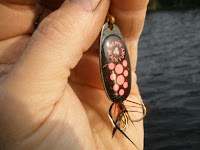

My favorite system is to cast the shoreline while being alert for any fish activity. I always position the boat so that the wind will drift me through the area I want to cast. If it's not too windy I shut off the outboard and let the wind do its thing. If it's very windy I might leave the engine turned on but in neutral, ready to reposition the boat should I drift out of position quickly.
The thing that I do that could be different from other anglers is that I continue to work an area for as long as I get any action whatsoever. For instance on my first drift through a spot I might only get a small pike or even just a strike. That's great, I figure, because it shows fish are here. So I head back upwind and drift through again, this time fishing either a little closer or a little farther out from shore or maybe trying a different lure.
I like to have two radically different lures on hand, usually a small Mepps or Blue Fox spinner in No. 3-5 and a medium-sized spoon.
In the photo above I caught a small hammer-handle pike the first time I went though this little cove on a No. 4 Mepps Black Fury spinner and had one other strike.
The next time I passed through I had another strike but no hook-up. Hmm, I thought, there are fish here but there's something not quite right with what I'm doing. It was evening and the light was starting to fade so I put on a Len Thompson No. 00 spoon, white with a fluorescent orange stripe. They should be able to see this, I thought.
I then caught six more pike in about 10 minutes, including two nice dinner fish about 25 inches long.
On another outing I kept drifting back through the same little spot for about an hour even though I was only catching miniature pike and even a perch. Although the fish were small it was pretty fast action. Finally I drifted through farther away from the shoreline and landed a nice 35-inch pike, the kind most people would like to catch.
I just find that by working an area thoroughly I develop a feel for the place. Sometimes I discover that all the fish are around a certain clump of weeds or some other structure. There may be lots of other weeds and structures around but on this day, every fish is clustered in this one little spot. And if there are little fish there are also likely to be big fish around.
If you don't keep going back to the area where you had fish action you might only get a single fish from this hot spot.
Click to go back to our website: www.bownarrows.com
Click to see the latest on the blog: www.bownarrows.blogspot.com












